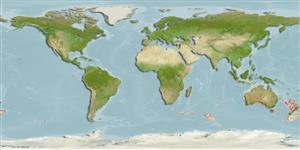>
Perciformes/Scorpaenoidei (Scorpionfishes) >
Sebastidae (Rockfishes, rockcods and thornyheads) > Sebastolobinae
Etymology: Trachyscorpia: Greek, trachys, -eia, y = rough + Greek, skorpis, idos = a kind of fish without identification (Ref. 45335); carnomagula: The specific name carnomagula is derived from the Latin carnosus meaning fleshy, and
magulum meaning jaw or mouth, in reference to the fleshy lip on the upper jaw, compared with the poorly developed lip of T. eschmeyeri. The E.
More on authors: Motomura, Last & Yearsley.
Environment: milieu / climate zone / depth range / distribution range
Ekologi
laut bentopelagis; kisaran kedalaman 731 - 1020 m (Ref. 58335). Temperate
Pacific Ocean: currently known only from the southwestern Pacific Ocean (Tasman Sea and northern New Zealand) at depths of 731-1020 m. One specimen (CSIRO H 2625-02, 263.3 mm SL, non-type), tentatively identified as T. carnomagula in ref. 58335 , was collected from southwest of Western Australia, Indian Ocean, at a depth of 738–750 m. Trachyscorpia carnomagula co-occurs with T. eschmeyeri.
Size / Weight / umur
Maturity: Lm ? range ? - ? cm
Max length : 36.9 cm SL jantan/; (Ref. 58335)
deskripsi pendek
Morfologi | Morfometrik
Duri punggung (Keseluruhan (total)): 13; vertebrata, bertulang belakang: 26. Tympanic spines present; upper-jaw lip well developed, covering most of premaxillary tooth band laterally; no scales on lateral surface of maxilla; 57–63 scale rows in longitudinal series; second pelvicfin soft ray short (17.9-24.9% SL, mean 20.3%), shorter than upper-jaw length; body deep (depth 34.3-42.5% of SL, mean 38.0%); orbit diameter large (14.1–18.0% of SL, mean 16.1%); pelvic-fin spine short (9.4–15.9% of SL, mean 12.4%); first anal-fin spine short (5.1–7.7% of SL, mean 6.4%); head profile convex; swimbladder
present; head and trunk whitish with two blackish bands from eye on head and 4 blackish saddles on body in preserved specimens (Ref. 58335).
Life cycle and mating behavior
Kematangan | Reproduksi, perkembang biakan | Pemijahan | telur-telur | Fecundity | Larva
Motomura, H., P.R. Last and G.K. Yearsley, 2007. Two new species of the scorpionfish genus Trachyscorpia (Sebastidae: Sebastolobinae) from the southern Indo-West Pacific, with comments on the distribution of T. eschmeyeri. Zootaxa 1466:19-34. (Ref. 58335)
Status IUCN Red List (Ref. 130435)
ancaman kepada manusia
Harmless
penggunaan manusia
informasi lanjut
Nama-nama umumSinonim (persamaan)metabolismePemangsaEkotoksikologiReproduksi, perkembang biakanKematanganPemijahanSpawning aggregationFecunditytelur-telurpekembangan telor
Umur / SaizPertumbuhanpanjang-beratpanjang-panjangukuran frekuensiMorfometrikMorfologiLarvaDinamika larvapemulihanKelimpahanBRUVS
AcuanBudidaya airprofil budidaya airStrainGenetikaElectrophoresesDiturunkanPenyakit-penyakitPengolahanNutrientsMass conversion
mitraGambarStamps, Coins Misc.Suara-suaraCiguateraKecepatanTipe renangArea insangOtolithsOtakPenglihatan / visi
Alat, peralatan
laporan khas
muat turun XML
Sumber internet
Estimates based on models
Preferred temperature (Ref.
123201): 2.1 - 7.5, mean 6.1 °C (based on 72 cells).
Phylogenetic diversity index (Ref.
82804): PD
50 = 0.5156 [Uniqueness, from 0.5 = low to 2.0 = high].
Bayesian length-weight: a=0.00912 (0.00410 - 0.02027), b=3.09 (2.89 - 3.29), in cm total length, based on LWR estimates for this (Sub)family-body shape (Ref.
93245).
Trophic level (Ref.
69278): 3.8 ±0.5 se; based on size and trophs of closest relatives
Daya lenting (Ref.
120179): Rendah, Waktu penggandaan populasi minimum 4.5 - 14 tahun (Preliminary K or Fecundity.).
Fishing Vulnerability (Ref.
59153): Low to moderate vulnerability (35 of 100).
